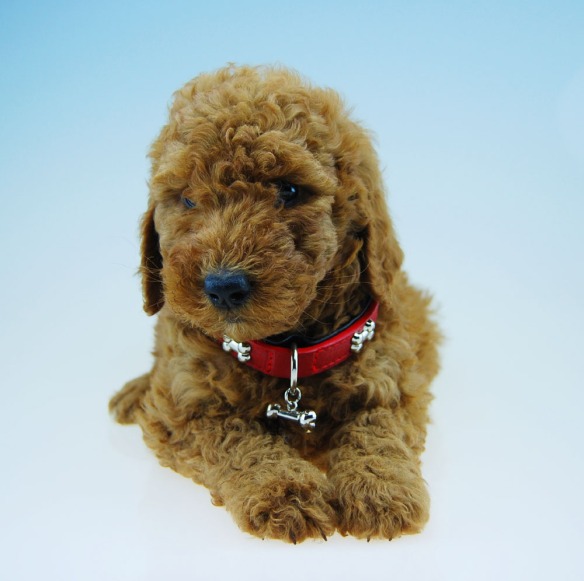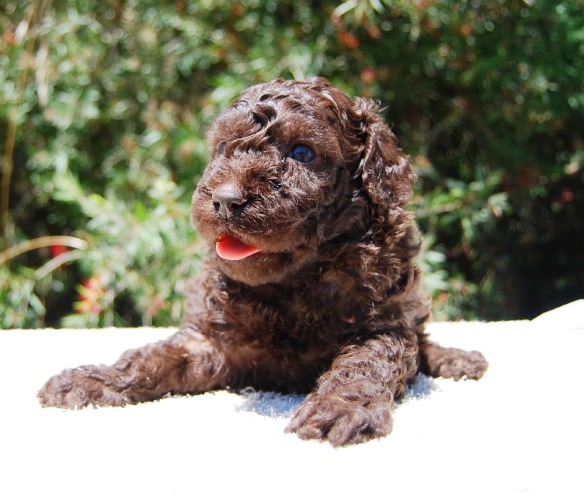(Labrador X Poodle)
Other names:
Doodle, Doodle Dog, Labrapoodle, Labrapoo, Poodle Retriever, (often confused with Groodles)
Introducing the Labradoodle:
The Labradoodle first came about in the 1980s when the Australian Guide Dog Association wanted to breed a dog that would suit allergy sufferers. Poodles were crossed with Labradors in the hope that the Wool non-shedding coat of the Poodle would be hypoallergenic. Soon other positive traits were found and the popularity of this wonderful breed grew to where the Labradoodle is one of the most easily recognised designer dog breeds.

Photo courtesy of Chevromist Kennels http://www.chevromist.com
Description of the Labradoodle:
Labradoodles are best described as the classic ‘shaggy dog’ that is always happy to meet everybody. Labradoodles look nothing like Labradors but some of the coat types do resemble the wool coat of the Poodle. Even with this concession, the Labradoodle has a unique look that is only matched by the very similar Groodle. A Labradoodle’s coat can fall into one of three main categories. Labradoodles can have hair coats, fleece coats or woolly coats but often do have coats that will show characteristics of two of these categories. Hair coats will shed, although not as much as a Golden Retriever’s coat. Labradoodles with fleece or wool coats shed the least and often are virtually non-shedding. Again it is always best to seek a Labradoodle puppy from someone who can advise you on your puppy’s final coat type. Labradoodles vary in size depending on the size of the Poodle parent.
Labradoodles are an overall healthy breed but both Poodles and Labradors have a higher rate of PRA (Progressive Retinal Atrophy) than many other breeds of dog. PRA is a genetic disease that leads to blindness later in life but can be DNA tested for. PRA is an autosomal recessive trait, meaning that both parents must carry the defective gene for any of their offspring to be affected. This means that all that is needed to prevent PRA in your Labradoodle is for one of your puppy’s parents to be DNA tested and be found to be clear of PRA. Responsible Labradoodle breeders will test for PRA in their breeding programs.
Temperament of the Labradoodle:
The most distinctive characteristic of a Labradoodle’s temperament is their friendliness to both other animals and children. Labradoodles are an easy going, fun loving breed that love to play with the whole family, swim and romp around with the entire family. The Labradoodle is a dog who enjoys being active with its family but is also happy to be an indoor pet as well. The Labradoodle’s original purpose was to be a low shedding assistance dog and these qualities make them suited to family life.
Labradoodle activity level:
Labradoodles are an intelligent breed that adores human companionship and is suitable for homes with a small to large yards. They love regular exercise and will benefit even from a walk, especially Labradoodles living in apartments or homes with small yards. As pups, Labradoodles are often described as “bouncy” as they tend to bounce around the kids as they get excited. As they get older, Labradoodles spend more of their time sleeping. Labradoodles are just as comfortable whether living with an active family surrounded by kids or in a quieter household.

Photo courtesy of Chevromist Kennels http://www.chevromist.com
Labradoodle colours:
Labradoodles are usually single coloured but white markings on the face, chest and feet are quite common. Labradoodles come in red, cream, black and chocolate but they can come in any various shades of these colours.
Grooming your Labradoodle:
The amount of grooming required for a Labradoodle will depend on the type of coat. Labradoodles of all coat types will require some grooming. The non-shedding Labradoodles also need to be clipped as their fur does not fall out. Labradoodles with Poodle like coats will need to be brushed more often than dogs with hair coats or Labradoodles with fur that is clipped shorter. Labradoodles, like all breeds with floppy ears, need to have their ears properly dried after their bath to avoid infections.
Training your Labradoodle:
Both Poodles and Labradors which make up the Labradoodle are highly intelligent breeds and the Labradoodle is a very quick learner. This and their high food drive, makes training your Labradoodle relatively easy. Early socialization and obedience are recommended for all Labradoodles, especially those that will grow to a medium or standard size. House training Labradoodles is also made easier as they prefer to go toilet away from where they sleep. Labradoodles do not require harsh or heavy-handed training methods and learn much quicker with food rewards. Training must be done with firmness, fairness, patience, and consistency. A puppy’s attention wanes after long periods of time, so try to make training times short and fun. Also make sure your Labradoodle puppy will come when called in the backyard before going out to an unfenced area.
Labradoodle size:
Mini Labradoodles grow to between 35cm to 45cm at the shoulder as adults.
Medium Labradoodles grow to between 40cm to 50cm at the shoulder as adults.
Standard Labradoodles grow to between 50cm to 60cm at the shoulder as adults.

Photo courtesy of Chevromist Kennels http://www.chevromist.com
Labradoodle life Span:
12 – 15 years
Finding Labradoodle puppies for sale from Labradoodle breeders
Labradoodles can still be classed as being fairly rare at this stage and locating a Labradoodle breeder can be a little difficult but one of the best ways is to go through a breeders agent. They will have contact with many different breeders and will usually be informed first of when litters are planned or available. A reputable breeders agent will also be able to provide you with further information on the care of your Labradoodle puppy as well as ensuring that the puppy has had the appropriate vaccinations, PRA testing, worming etc and is the right age to go to their new home. We have found Chevromist Kennels to be exemplary in their level of knowledge and service both before and after adopting a puppy and have no hesitation in recommending them to anyone wishing to adopt a Designer breed puppy. You can visit their website with photos of their beautiful puppies at www.chevromist.com







Pingback: Puppy Training Basics | Designer Dog Info
Pingback: Choosing between a male or female puppy | Designer Dog Info
Pingback: Puppy’s first collar | Designer Dog Info
Pingback: Training your puppy to accept a leash | Designer Dog Info
Pingback: Jhordis Anderson dog quote | Designer Dog Info
Pingback: Edith Wharton dog quote | Designer Dog Info
Pingback: Your puppy’s first day home | Designer Dog Info
Pingback: Labradoodle dog mistaken for a lion! | Designer Dog Info
Pingback: Ways to dry your dog’s coat | Designer Dog Info
Pingback: How to stop dogs jumping up on people | Designer Dog Info
Pingback: Finding the best pet insurance | Designer Dog Info
Pingback: Tips for exercising your dog | Designer Dog Info
Pingback: 3 Diseases You Need to Watch Out for in Puppies | Designer Dog Info
Pingback: Puppies and Stairs | Designer Dog Info